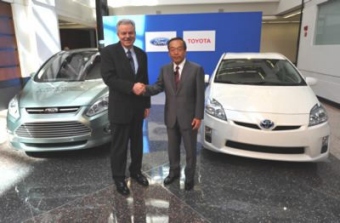
Automotive Intelligence - the web for automotive professionals and car enthusiasts
August 26, 2011
This Week:
-
The New Bentley Continental GTC Will Debut at IAA motor show
-
Cadillac Ciel Concept Makes European Premiere At Frankfurt IAA
-
The new Porsche 911 Carrera Makes World Debut at the 2011 IAA Frankfurt Motor Show
-
New Chevrolet Malibu To Celebrate European Debut At IAA In Frankfurt
-
Even more sportiness and individuality for the BMW X5 and BMW X6
-
Kia to unveil four-door sports sedan concept at Frankfurt Motor Show
-
All-New Mazda CX-5 World Premiere at 2011 Frankfurt Motor Show
© 1998 - 2011
Copyright &
Disclaimer
Automotive Intelligence,
www.autointell.com
All Rights Reserved .
For questions please contact
editor@autointell.net
|
Ford, Toyota to Collaborate on Developing New Hybrid System for Light Trucks, SUVs; Future Telematics Standards
Derrick Kuzak, Ford group vice president, Global Product Development, (left) and Takeshi Uchiyamada, Toyota executive vice president, Research & Development, sign a Memorandum of of Understanding to collaborate on a new rear-wheel-drive hybrid system for light trucks and SUVs, and to collaborate on development of next-generation standards for in-car telematics. DEARBORN, Mich. – Ford Motor Company and Toyota Motor Corporation – the world’s two leading manufacturers of hybrid vehicles – today announced they will equally collaborate on the development of an advanced new hybrid system for light truck and SUV customers. Ford and Toyota have signed a memorandum of understanding (MOU) on the product development collaboration, with the formal agreement expected by next year. |
|
|
|
|
|
Both companies have been working independently on their own future-generation rear-wheel drive hybrid systems. The two now have committed to collaborate as equal partners on a new hybrid system for light trucks and SUVs. This new hybrid powertrain will bring the full hybrid experience of greater fuel efficiency to a new group of truck and SUV customers without compromising the capability they require in their vehicles. Ford and Toyota believe that their collaboration will allow them to bring these hybrid technologies to customers sooner and more affordably than either company could have accomplished alone. “This agreement brings together the capability of two global leaders in hybrid vehicles and hybrid technology to develop a better solution more quickly and affordably for our customers,” said Derrick Kuzak, Ford group vice president, Global Product Development. “Ford achieved a breakthrough with the Ford Fusion Hybrid, and we intend to do this again for a new group of truck and SUV buyers – customers we know very well.” Takeshi Uchiyamada, Toyota executive vice president, Research & Development, said: “In 1997, we launched the first-generation Prius, the world’s first mass-produced gasoline-electric hybrid. Since then, we have sold about 3.3 million hybrid vehicles. We expect to create exciting technologies that benefit society with Ford – and we can do so through the experience the two companies have in hybrid technology.” The two companies also agreed to work together on enablers to complement each company’s existing telematics platform standards, helping bring more Internet-based services and useful information to consumers globally. |
|
Under the MOU agreement, the two companies will bring the best of their independently developed hybrid powertrain technology and knowledge to a new co-developed hybrid system, which will be used in rear-wheel-drive light trucks arriving later this decade. Specifically, Ford and Toyota will:
•Jointly develop as equal partners a new rear-wheel drive hybrid system and component technology for light trucks and SUVs
•Independently integrate the new hybrid system in their future vehicles separately
For years, both Ford and Toyota have been working independently on similar new rear-wheel-drive hybrid systems aimed at delivering higher fuel economy in light trucks and SUVs. When the two companies began discussing this potential collaboration, they discovered how quickly they were able to find common ground.
“By working together, we will be able to serve our customers with the very best affordable, advanced powertrains, delivering even better fuel economy,” said Ford President and CEO Alan Mulally. “This is the kind of collaborative effort that is required to address the big global challenges of energy independence and environmental sustainability.”
Toyota President Akio Toyoda added: “Toyota is extremely proud to join Ford in developing a hybrid system for pickup trucks and SUVs. Not only is this tie-up clearly one aimed at making automobiles ever better, it should also become an important building block for future mobility in the U.S. By building a global, long-term relationship with Ford, our desire is to be able to continue to provide people in America automobiles that exceed their expectations.”
This rear-wheel-drive hybrid system will be based on an all-new architecture to deliver the capability truck and SUV customers demand while providing greater fuel economy. While the rear-wheel-drive hybrid system will share significant common technology and components, Ford and Toyota will individually integrate the system into their own vehicles. Each company also will determine the calibration and performance dynamics characteristics of their respective light pickups and SUVs.
In addition, as telematics plays an increasingly more important role in the in-car experience, both companies have agreed to collaborate on standards and technologies needed to enable a safer, more secure and more convenient in-car experience for next-generation telematics systems. The telematics collaboration relates only to standards and technologies, and each company will continue to separately develop their own in-vehicle products and features.
Photos: Ford/Toyota
(Aug. 22, 2011)

